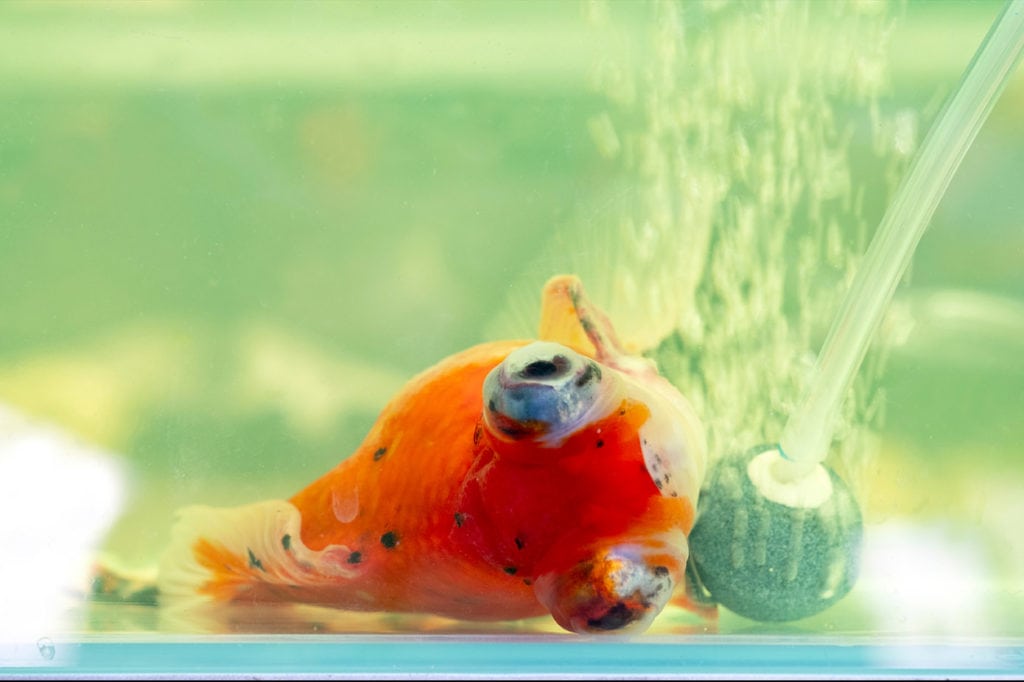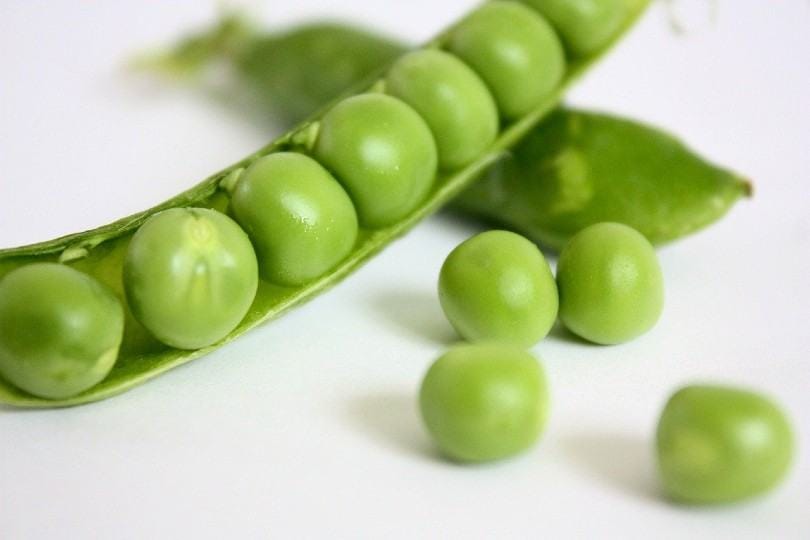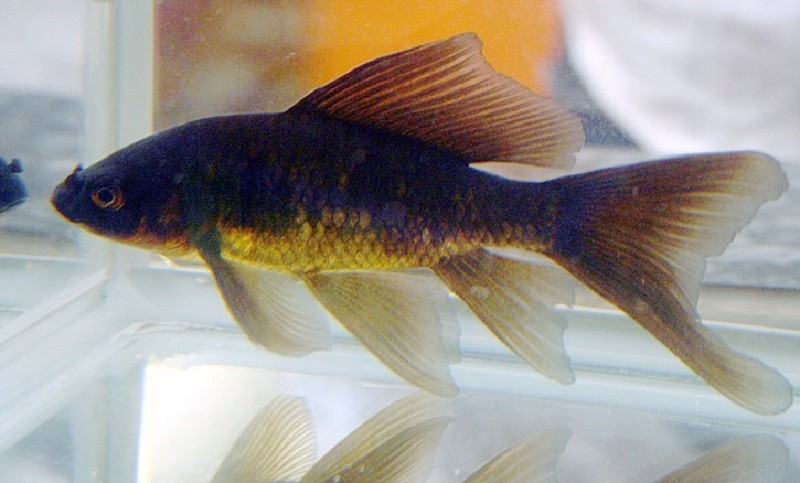
One of the most common problems with fancy goldfish is that they are highly susceptible to developing a disorder of one or both swim bladders. Depending on the cause of the swim bladder disorder, it is usually not fatal and there are various treatment options to help your goldfish overcome swim bladder disorder.
Goldfish are born with two swim bladder organs. In a common, comet, and shubunkin goldfish, it is structured appropriately inside of their body. Unfortunately, fancy goldfish like fantails, Ranchu, Orandas, or black moors have compressed internal organs and the stomach puts excess pressure on the nearest swim bladder.
In this article, we will be informing you on how to identify signs of swim bladder disorder and how to treat and prevent it from happening to your goldfish.
Swim Bladder Disorder Explained
The swim bladders are air-filled organs that goldfish use to maintain their balance and buoyancy in the water. The swim bladder near the rear is usually the largest and opens directly into the goldfish’s gut. The goldfish will inflate or deflate the swim bladder organs to swim around the tank in a controlled manner.
It is common for goldfish to gulp at the surface after a meal to keep their buoyancy at zero. The swim bladders are a tubular shape and are compacted in the rounded bodies of fancy goldfish. This makes them at risk of developing buoyancy issues as soon as any pressure is placed on the swim bladders. The front air bladder has small bones at the back of the skull and is attached.
Swim bladder disorders affect the way the goldfish will swim and can cause them to swim on their side, upside down, or continuously sink to the bottom. This is a stressful experience for the fish, and they need to be treated promptly. Aside from their difficulty swimming, the fish will appear healthy.

Signs of Swim Bladder Disorder
Treating Swim Bladder Disorder in Goldfish
Step 1: Move the infected fish into a treatment tank. This ensures you do not pollute the main tank with any medications.
Step 2: Use an aquarium heater to gradually increase the temperature between 24° to 26°C.
Step 3: Add in 2 teaspoons of Epsom salts per gallon of water.
Step 4: Treat for bacteria in the swim bladder with NT Labs Swim Bladder Treatment or Seachem Focus.
Step 5: If you rule out a bacterial issue, boil and deshell a pea and squish it between your fingers for the goldfish to eat.
Step 6: Gently massage the goldfish’s stomach to release the trapped air.

5 Preventative Measures to Try
- Keep the water in the goldfish tank clean using a filter and frequent water changes. Dirty water is a breeding ground for different bacteria that may infect the swim bladder organ.
- Feed high-quality food alongside algae pellets and blanched green vegetables.
- Feed your goldfish less protein to avoid constipation.
- Avoid housing goldfish in tall tanks.
Peas as a ‘Cure’
Normally the first treatment method that comes to mind when a goldfish develops swim bladder issues is to feed it peas. Peas are praised as a cure for the disorder, but this is simply not true. Peas have nothing special about them and they do not contain anti-bacterial properties to kill off a possible bacterial infection in the swim bladder organ.
Peas are generally fed to make your goldfish pass waste easier, but it will not work for cases where pathogens or genetic disorders are a problem.

The Truth About Fasting Goldfish
Aside from feeding peas, many goldfish keepers will recommend fasting the goldfish when they have swim bladder disorder or claim it is a preventative measure if done once a week. When you fast goldfish or deprive them of food, the stomach will shrink to its original size as it does not have to support a meal. When you begin to feed the goldfish again, their stomach will rapidly expand, and this can cause a stomachache and promote bloating.
The effects of the bloating will put excess pressure onto the swim bladder organ. Fasting is not recommended as a preventative measure or treatment option for a swim bladder disorder. It will ultimately do more harm than good.
All fish should have constant access to food in small amounts throughout the day. Large meals once a day can contribute to bloat and your goldfish may suffer from swim bladder issues throughout its life.
Bacterial Infection of One or Both Swim Bladders
The swim bladder organs are at risk of being impaired by a bacterial infection. This is one of the most common reasons goldfish get swim bladder disorder. Dirty water is the main reason the swim bladders can be infected with certain bacterial pathogens. Fortunately, this can easily be treated using medications that treat Aeromonas or Pseudomonas bacteria.
A water change will also help to combat the problem.
If your fish isn't behaving or looking as it normally does and you suspect it may be sick, ensure you provide the right treatment, by checking out the best-selling and comprehensive book The Truth About Goldfish on Amazon today. It has entire chapters dedicated to in-depth diagnoses, treatment options, a treatment index, and a list of everything in our fishkeeping medicine cabinet, natural and commercial (and more!).
Genetically Faulty Swim Bladder Organs
Fancy goldfish are over-bred to produce abnormal body types and features. This results in the organs being compacted in an unnatural form. It is not uncommon for fancy goldfish to have one swim bladder organ genetically deflated. This will lead to the goldfish developing chronic swim bladder issues that will occur throughout its life. They are usually unstable in the water and will take frequent rests along the bottom of the aquarium. You may also notice that they get floaty after a heavy meal.
Constipation
Constipation is a common occurrence in goldfish that are fed an inadequate diet. Goldfish should not be fed a staple food that has high amounts of protein. Goldfish rely on vegetable matter and algae to have a smooth digestion process. If you feed your goldfish more live foods and commercial mixes tailored towards carnivorous fish, they are likely to develop swim bladder disorders. Feeding your goldfish foods rich in fiber is a good preventative measure against constipation.
Wrapping It Up
Although goldfish develop issues with their swim bladder regularly, if you follow the correct preventative measures and feed them a high-quality diet, your goldfish will be less likely to develop any swim bladder disorder. Since fancy goldfish with abnormal body types are at risk of developing this issue more easily, try to only keep goldfish that have a somewhat natural body shape similar to common or comet goldfish. Avoid purchasing goldfish like pearl scales or Orandas if you do not want to deal with genetically compromised swim bladder organs.
We hope this article has helped you to diagnose and treat your goldfish effectively.
Featured Image Credit: M-Production, Shutterstock











